Rescue of an impala fawn from Maasai mara National Reserve This was a case of an Impala fawn that was found abandoned on the plains of the Masai Mara National Reserve by resident Masai who later confirmed that the mother had been killed
Rescue of an impala fawn from Maasai mara National Reserve
This was a case of an Impala fawn that was found abandoned on the plains of the Masai Mara National Reserve by resident Masai who later confirmed that the mother had been killed. He then rescued the animal, took it home and fed it on goat milk for two days before handing it over to Anne Kent Tailor's desnaring team who were doing patrols in the area. It was later fed on UHT milk but was beginning to weaken before being airlifted to Nairobi the following day. The animal developed a slight diarrhea which later resolved by itself.
The animal was received from Wilson Airport by a veterinarian and animal keepers from David Sheldrick Wildlife Trust (DSWT) and it was taken to DSWT animal orphanage in Nairobi. It was treated with long-acting antibiotics and multivitamins then bottle-fed on warm Safariland milk.
It appeared weak and dehydrated but was able to drink so it could still survive, enough warmth was provided by having the animal staying in stabled cushioned with blankets. The intention was to let it stay under closer attention for a few days then later taken to Tsavo East animal orphanage to join a Lesser kudu for company.
The fawn survived for 4 days while being bottle-fed on milk then it developed acute pneumonia and later died while undergoing treatment.
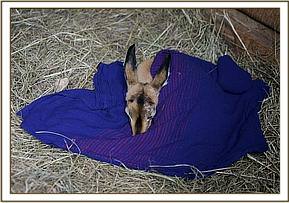
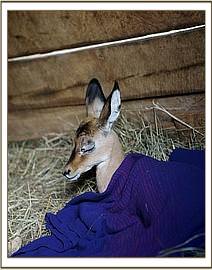
Naivasha Nile hippos and Buffalos mortalities
It was reported to the veterinary department that buffaloes were dying in Colour Crop farm, Loldia farm and Marula farm. By the time of reporting more than 10 buffaloes had died in Colour crop farm, 2 in Loldia and 1 in Marula farm. There was therefore need to carry out a postmortem on the dead animals and then do an investigation to confirm the cause of these mortalities and to then come up with control measures.
Four buffalo carcasses of between 1 – 3 days old were found in Colour Crop farm, they were all adult males that were in good body condition and died in close proximity of each other. The significant postmortem signs observed were oedematous swellings of the perineum and anal region, generalized emphysema / bloated carcass, dark and watery blood with air bubbles.
No carcass was opened up for detailed examination because anthrax infection was suspected in all the four carcasses examined and proper immediate proper disposal by burial and application of quick lime on the ground and on the carcass was recommended. Blood smears were made from the oozing blood from the nostrils because the superficial ear-veins had collapsed and dried. These smears were fixed in 1% Mercuric chloride and submitted to the laboratory for examination. In two of the slides rods of bacteria resembling those of anthrax were observed under the microscope, but the slides were not the best since the smears were watery with little contents to observe after staining. Eight buffaloes from the affected herds were immobilized and blood samples collected for screening in the lab.
A tentative diagnosis of anthrax infection was made after observing the postmortem lesions and the outcome of the blood smears. Later on when 12 Nile hippos died in the same location as buffaloes another postmortem examination was carried out and tissue samples and more blood smears collected for further laboratory tests, it was suspected that the same infection in buffaloes was transmitted to hippos through pasture and water contamination.

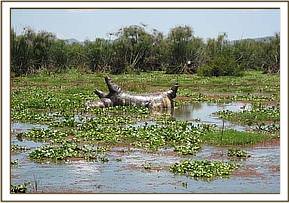
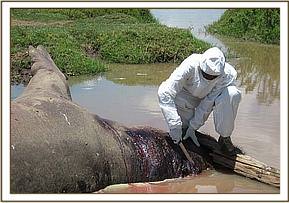
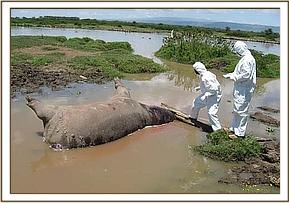

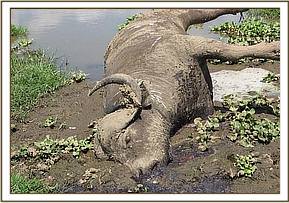
Treatment of zebra snare wounds in Naivasha
On 8th/3/07 at 3.00pm we received a report from the manager of Marula ranch that a male adult zebra was seen limping within the ranch and needed veterinary intervention. The animal was snared about two weeks previously but the wire had fellan off but not before inflicting a severe injury on the carpal joint of the left front limb. The zebra was sighted while in the company of a younger foal, it had difficulty in walking and it was reported that it had been limping for more than two weeks.
The wound was chemically debrided using 10% hydrogen peroxide followed by application of tincture of iodine and sprayed by oxytetracycline spray. It was further treated using antibiotics, multivitamins and dexamethasone anti-inflammatory drug, these were administered intramuscularly. Prognosis was good after the treatment as the animal was still in good body condition and arthritis had not yet set in. The animal was then revived and released back to the wild.
During treatment and after the treatment of a snare wound in Naivasha.
On 9th/3/07 at 10.00 am while on a patrol of Naivasha area, a male adult zebra in a company of other zebras was found limping near Gilgil toll station. It had a wound on the planter side of the left hind limb encircling the distal metatarsal region, it was not so severe but the animal was in pain and kept lagging behind and clearly had difficulty in walking and as a result had lost body condition. We therefore decided to do something to alleviate this pain and suffering. It was then immobilized by darting from a vehicle and after a few minutes it went recumbent and the wound was treated and revived from anaesthesia. Prognosis for this animal was good.
On 10th/3/07 an adult male zebra was found with left front limb completely cut off at the fetlock joint. It could only move by jumping while holding the severed limb, it seemed to have adapted to walking on three legs. Two zebras had a similar condition in the group that we were observing and we decided to attend to them one after the other. These animals were very shy we only managed to immobilize one by darting from a vehicle after trying for a long time. We thought of euthanizing the animal but after examining the limb I realized that it was only the hoof that had detached leaving a raw wound, the hoof is likely to grow sometimes after the treatment. The zebra was therefore treated for the wound by topical application of tincture of iodine and intramuscular administration of antibiotics, multivitamins and antinflammatory drug.
The prognosis was favourable after treatment as the wound will heal and the hoof re-grows. The animal was then revived and released back to the wild. On that same day we received a call from Marula farm that they had found a dead Heartbeest whose cause of death was not known, this required a postmortem examination to ascertain the cause of death before advanced decomposition. There was also another call from Masai Mara national Reserve that there was an elephant with a greatly swollen front limb that could hardly move and this required an urgent veterinary attention. So we left the other zebra to be treated the following day.
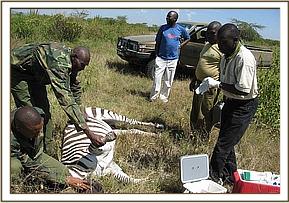
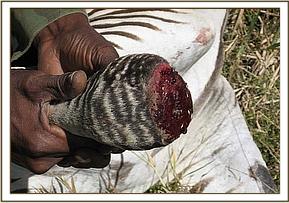
Postmortem examination of a Heartbeest in Marula farm Naivasha.
The heartbeest was found dead on 10th/ 3/ 07 in the morning and the carcass was not yet fully decomposed, part of it especially the head region had been preyed on by the vultures. Significant signs found during the postmortem examination were greatly enlarged gall bladder and the omasum (book stomach) was full of hardened stomach contents, there was a heavy infestation of different species of hard ticks (Rhipicephallus and Amblyoma species) attached on the inner side of the ear-pinna. These signs were indicative of Anaplasmosis infection, blood smears and tissue samples from different organs such as the liver, heart, spleen, lymph nodes and kidney were collected for further laboratory analysis. The animal seemed to have died of a chronic infection as it had lost the body condition by the time it died.
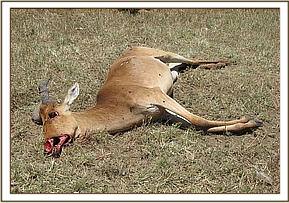
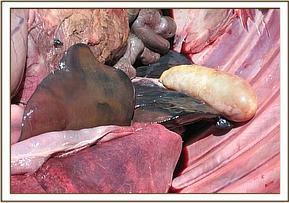
Treatment of an elephant in Masai mara
On 11th/3/07 at 9.00 am we treated an adult male elephant in Masai mara National Reserve just a few kilometers from Talek center. It had a deep penetrating wound on the medial side of the tarsal joint of left front limb. The elephant could barely walk due to extreme pain and swelling of the limb so it decided to remain standing at the edge of a small stream where it could get water and food without walking for long. It was immobilized by darting from a vehicle and it moved for only a few meters and stopped. After a few minutes it went recumbent and we moved in to examine the limb. On the medial side slightly above the spool was a small penetrating wound with little pus oozing from it, the entire limb was swollen as compared to the other front limb oozing pus, it was suspected to be an arrow wound deep in the joint.
There were two other superficial wounds at the back of the animal that extended deep under the skin and much of the tissues in this region had necrotized. The wounds were treated topically and the animal administered with dexamethasone to alleviate pain and reduce the swelling, long acting oxytetracycline antibiotic was also administered intramuscularly for the treatment.
The elephant was then revived from anaesthesia, it kept struggling and was clearly finding it difficult to rise up due to the paintful wound so we decided to pull it up using ropes and pulled by a Toyota Landcruiser pick-up, it then managed to rise to his feet after a short struggle.
The prognosis was clearly not good for this animal and chances of recovery were quite slim because of the pain elicited by the wound on the limb that had stayed for some time but we decided to treat and keep monitoring the response which was to determine on whether to repeat the treatment was necessary or if we had to euthanize it..
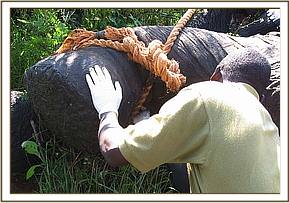
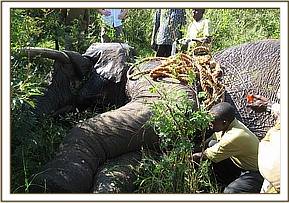
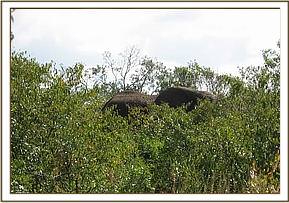
Zebra case on Kari Farm Naivasha
The next day we proceeded to Naivasha KARI farm to continue treating zebras. The following day on 12th/3/07 while patrolling in the farm we encountered another zebra whose hoof was cut off by a tight wire snare and decided to attend to it, this animal was immobilized by darting from a vehicle and it took about 8 minutes to become recumbent. On physical examination, the zebra had a wound on the right hind limb from where the hoof got detached by the wire snare; this was well treated with debridement using 10% hydrogen peroxide then tincture of iodine applied onto it and oxytetracycline antibiotic spray applied. Long acting 20% oxytetracycline was administered intramuscularly followed by multivitamin and antinflammatory injection. The animal was then revived from anaesthesia and released to the wild.
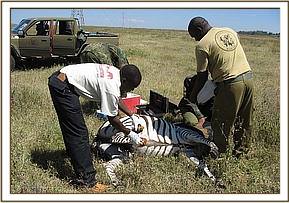
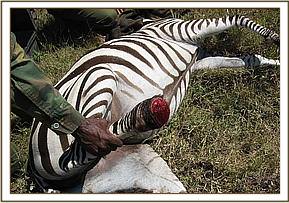
Masai mara lion carcass it was suspected to have eaten a poisoned meat.
A case of sick and dead lions in Masai mara National Reserve, the veterinarian received a phone call from an area called Mararianda just at the periphery of Masai mara National Reserve reporting that they had spotted an adult male lion that appeared weak, staggering and vomiting, they suspected that the animal had eaten a poisoned carcass and called for immediate veterinary attention. When the veterinary team arrived the following day the sick lion could not be found and instead we found a two-day old carcass of a sub-adult male lion. The carcass had been preyed on by hyenas and vultures hence no viable samples could be used for analysis. The other lion could not be seen and the assumption was that it had recovered from poisoning and left the area.
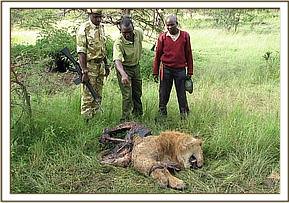
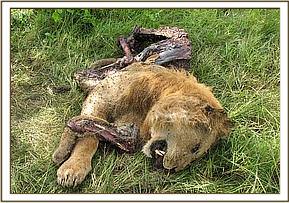
Treatment of Topi
Treatment of an injured Topi in near Talek in Masai mara, the veterinary team saw this animal limping just next to the road as were still searching for a Cheetah. It had a deep wound on the thigh of the right hind-limb the wound was just a few hours old and had bloody discharges flowing. For treatment it was immobilized through darting from a vehicle using 6mgs of etorphine hydrochloride combined with 30mgs of xylazine hydrochloride and it became recumbent after about 6minutes. The wound was flushed using hydrogen peroxide followed by tincture of iodine and sprayed with oxytetracycline antibiotic spray. It was also treated with intramuscular administration of Betamox a long acting antibiotic.
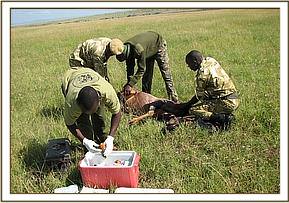
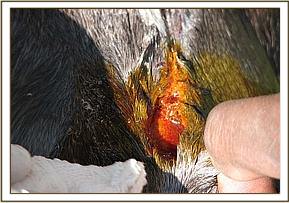
Cheetah case with Mange
This was a case of a male adult cheetah that was in a group of two other sub-adult males, it had marked alopecia with crusty skin and lots of dundruft that could be seen from far. The other two cheetahs also had similar symptoms but to a lesser extent. This skin condition could be either due to mange infestation or fungal infection. The cheetah was then anaesthetized using 100mgs of xylazine hydrochloride combined with 100mgs of ketamine hydrochloride through darting from a vehicle.
It was quickly treated by subcutaneous administration of Ivomectin, Betamox and multivitamins administered intramuscularly. Ectopour pour-on was also applied onto the skin just incase it had fleas or tick infestation. Skin scrappings were collected from these skin lesions for laboratory analysis, these revealed the presence of Sarcoptic mites. The animal was then revived from anaesthesia but developed convulsive movements that was counteracted by administration of diazepam and physical restrain. It was then released after sometime and it joined others nearby. The following day it was still drowsy and was not able to hunt so we decided to buy and feed it on goat meat that they all ate. Prognosis was good after that treatment and it was still in good body condition.

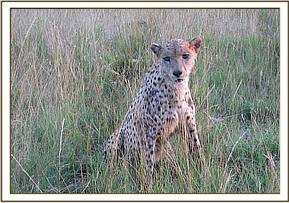
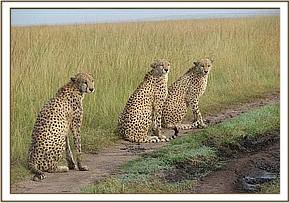
Desnaring of two Masai giraffes in Crater Lake in Naivasha area.
This was a case of two giraffes that got snared in Crater Lake, the veterinary team arrived at the place immediately after receiving a phone call concerning these animals. The first giraffe to be desnared was an adult male giraffe found alone just next to the road and had a wire snare on the right front limb. It was quickly immobilized by darting using 13mgs of etorphine hydrochloride combined with 30mgs of xylazine hydrochloride, the drug took effect after 6 minutes and the animal was put on lateral recumbency using ropes.
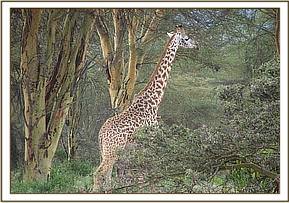

The wire was still loose and had not inflicted severe injury on the limb, so it was cut off using a wire cutter, the limb sprayed with antibiotic spray and the animal revived from anaesthesia immediately.
The second giraffe was later found just nearby; it was found lying and had a long intertwined wire dangling on its left front limb, this was a sub-adult male giraffe. It was also chemically immobilized through darting using 12mgs of etorphine hydrochloride combined with 30 mgs of xylazine hydrochloride and took about 5 minutes to become narcotized. The wire was cut off using a wire cutter and the animal treated with antibiotics for possible infection. It was then revived and released to the wild.
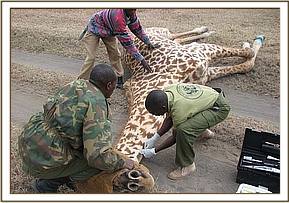

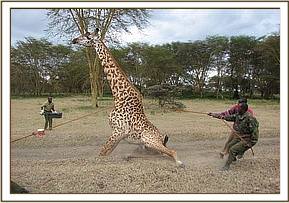
Treatment of injured common zebras in Marula farm in Naivasha.
There was a case of a young zebra that was in a group of many zebras just a few kilometers from Gilgil Toll station, it had no visible wound or foreign material on the limbs but it was seriously limping and could not bear weight on its left front limb. We decided to have the animal restrained so that we could ascertain the type of condition it was. The animal was then immobilized by darting from a vehicle and went recumbent after 5 minutes.
The limb was examined and found to have scars of a healing wound, the animal sustained injuries that extended into the carpal joint developing a chronic arthritis and this elicited a lot of pain while walking. It was treated using long acting (20%) oxytetracycline administered intramuscularly followed by dexamethasone and multivitamins then revived from anaesthesia and joined the rest. It had better chances of healing after the treatment.
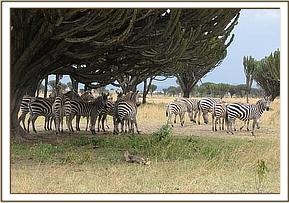

Treatment of a zebra with a bite wound on the front limb in Marula farm.
This animal was found limping and isolated from the rest of the herd, it had a large wound on the left front limb and it had lost body condition. It was anaesthetized by darting from a vehicle after a short chase. The drug took effect after about 6 minutes and the animal became recumbent. The wound was properly debrided using hydrogen peroxide then flushed with tincture of iodine and antibiotic spray applied onto it. Long acting antibiotics and antinflammatory drug was administered then the animal revived from anaesthesia and released.


Prepared by; Dr. Domnic Mijele.